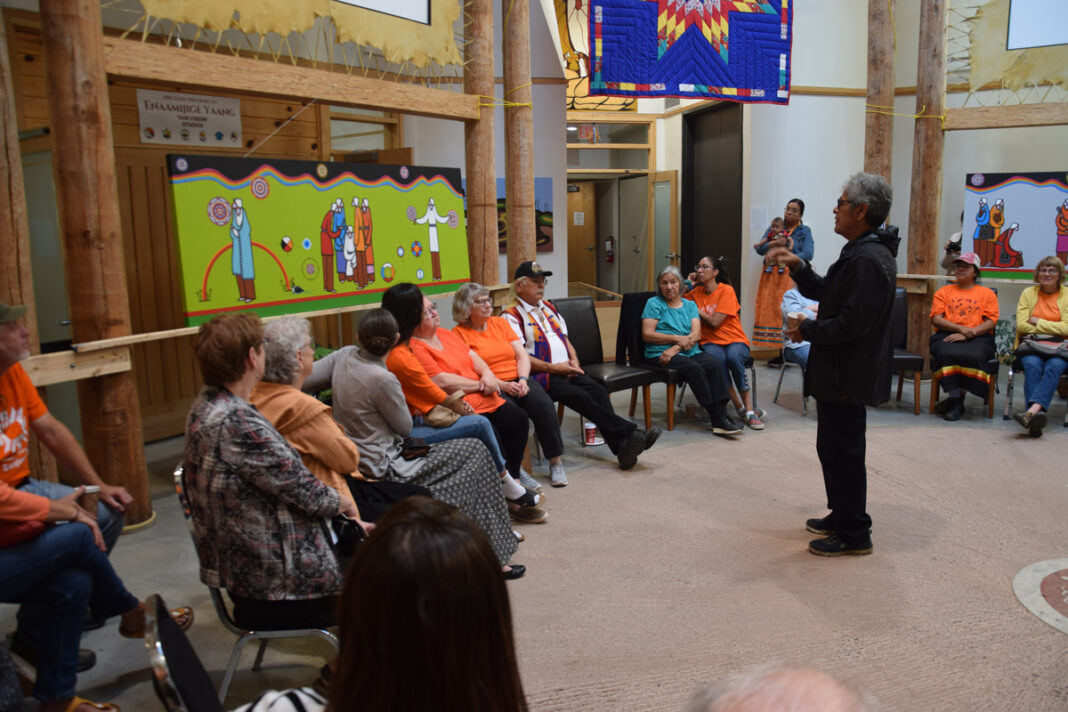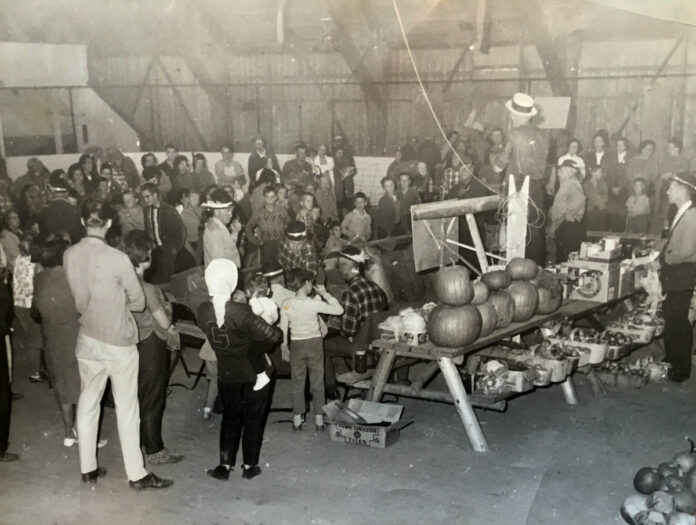M’CHIGEENG—Internationally renowned Anishinaabe artist Leland Bell delivered an artist’s talk in the foyer of the Ojibwe Cultural Foundation where ‘Miikaan: A Leland Bell Exhibit,’ featuring a collection of his work, is currently on display. The main focus of Mr. Bell’s talk was on a series of large panels that surround the foyer and depict his life journey along the path of the Midewiwin Lodge.
Mr. Bell was accompanied on his talk by a number of elders. Mr. Bell and elder Marie Eshkibok-Trudeau spoke before the lunch break and elders Stanley Peltier and Dan Commanda spoke after. An audio-visual presentation featured interviews from Giigidowin (2021) in which the elders discussed art, ceremony, life and stories.
Following a short introduction by OCF assistant curator Shaelynn Recollet, Mr. Bell stepped into the circle and addressed those in attendance in Anishinaabemowin, recognizing the day as one to honour those who survived the residential school system and the Missing and Murdered Indigenous Women and Girls. As the presentation was taking place on National Day for Truth and Reconciliation (and the grassroots Orange Shirt Day memorializing the children who never returned home from residential school) many in the audience were wearing orange.
Mr. Bell began his artist’s talk with a joke made at his own expense, a recuring theme in much of this most gentle of artists’ conversation. The artist apologized in advance for any stumbles he might make in his presentation, noting it has been nearly a quarter century since he did any serious public speaking.
“I’ve always been very proud to be an Anishinaabe person,” said Mr. Bell. “I don’t have a crisis of identity,” he quipped, “I just know where I’m from.” Mr. Bell is from Wiikwemkoong Unceded Territory, but has spent many recent years in Sudbury or travelling the Three Fires territories to visit and learn from Anishinaabe elders.
“Age is not the main thing,” he points out in explaining his own interpretation of elder. One can find wisdom and knowledge among the very young or the very old, pointed out Mr. Bell, deftly avoiding the obvious counterpart to that observation.
“Language is very important to me,” said Mr. Bell, noting his own fluency remains a work in progress.
Mr. Bell acknowledged the grants he received during the recent pandemic that allowed him the time and space to create the panels he would be talking about during his time in the circle. Those include the Canada Council for the Arts and the Ontario Arts Council and the OCF itself in providing the exhibition space.
He also acknowledged the 10 different elders whose wisdom has been foundational in his work but cautioned that his talk would be primarily a “me session,” to which his audience responded with laughter. The artist’s ‘self’ is practically unavoidable when it forms the base of an ‘artist’s talk.’
Mr. Bell said that from the time he was quite young, his sole ambition was to be Anishinaabe. “Not part, not full, nothing other than that,” he said. “What am I now? I don’t know myself,” he chuckled. But the works on display document his journey along the “Anishinaabe Miikan” (the Anishinaabe road) “up to this point in time.”
The artist pointed out that when he first set out on the Anishinaabe Miikan, “cultural wasn’t ‘in’.”
He described his introduction to culture and art at the famed Schreiber Art Camp (founded by Tom Peltier baa, an influential Wiikwemkoong band member who would go on to work in the prime minister’s offices of both Lester B. Pearson and Pierre Trudeau, before being tasked with travelling the country collecting Indigenous art for the National Gallery).
Mr. Bell recalled how a friend (unnamed as his passing is too recent for his name to be spoken, less it interrupt his spirit journey) convinced him to go to the camp. There he found practitioners of all forms of art taking place under the mentorship of luminaries such as Ojibwe artist Daphne Odjig baa and Cree artist Carl Ray baa. The camps stopped for a brief period and then resumed under the wing of the OCF.
During his artist’s talk, Mr. Bell described his method, which includes placing many light coats of pigment on the canvas to accomplish the smooth, brilliant colours that characterize his work. “I could put it on heavy and scrape it off,” he suggested, “but that isn’t how I paint.”
The background colours, orange, green, grey and blue, utilized by Mr. Bell in his four panel Miikan series, have deep symbolic meanings to the work and his journey along the Midewiwin path. Mr. Bell admitted uncertainty about the meaning behind the grey background, but elder Eshkibok-Trudeau explained grey is the colour of the spirit level in her later remarks.
Orbs float around the figures in the paintings, at first nebulous, but then gaining greater detail within.
The figures’ posture within the paintings plays an important role in the story, with all but the gift giver in the final panel facing in the same direction, the Midewiwin path coming to all of the people. Drums, gifts, gathered groups, elders, the water carriers, pipe carriers; all of those that carry knowledge can be found depicted on the paintings.
In the third last panel, the orbs descend toward three fires, with half of the figures facing the same direction. In the final panel, the orbs float among the people who are gathered with the gifts of knowledge from the ancestors.
Among the collection in the Miikaan exhibit are other art mediums, carvings and mosaics, which form part of Mr. Bell’s journey and development as an artist. He noted his early work, mostly featuring shapes, has come a long way down the path. One unusual series of five panels, ‘Maasoweh,’ is presented on three circular panels, separated by tall rectangles. The presentation is indicative of digital ones and zeros.
‘Miikaan: a Leland Bell exhibit’ runs at the OCF until November 12 and tells the story of the development of Mr. Bell into one of the globe’s foremost artists.





